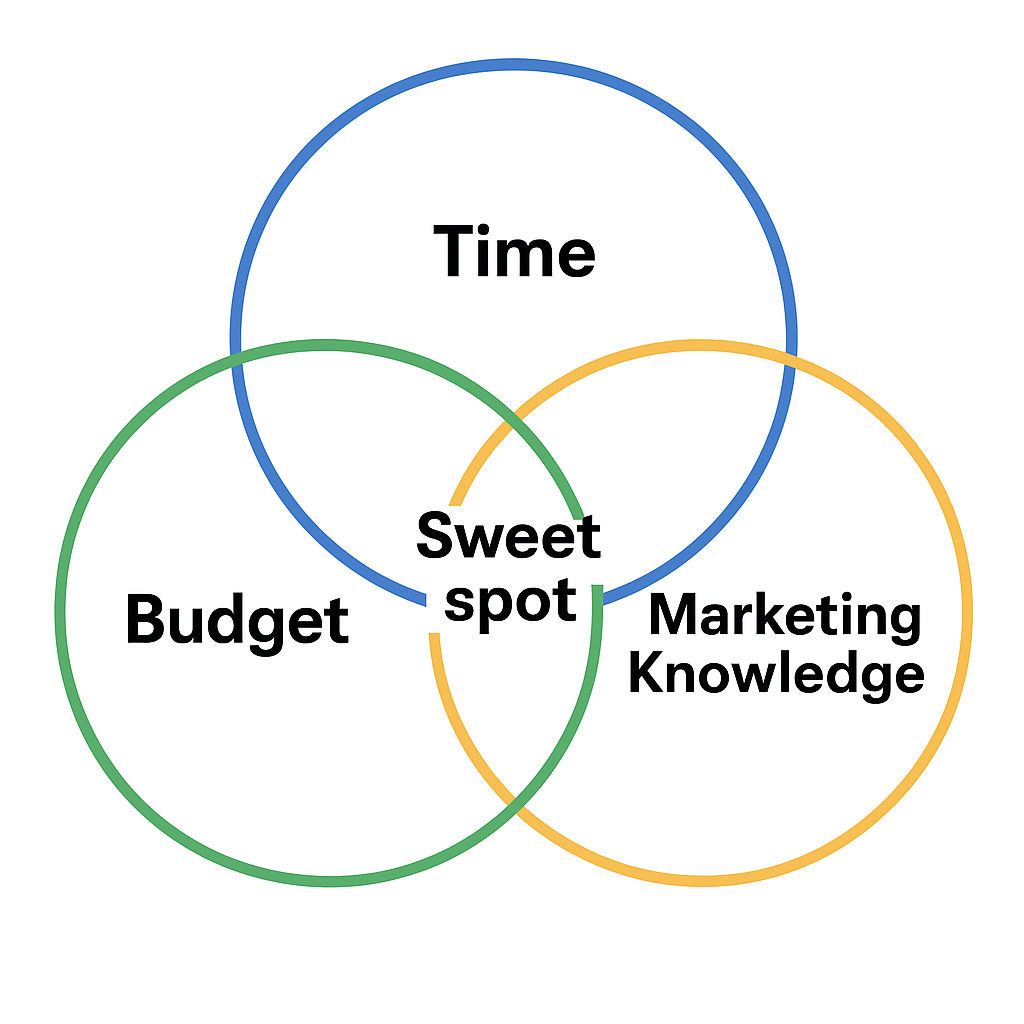
Running a small business often feels like spinning plates on a windy day. You’re the owner, the operator, the customer service lead, the stock controller, the cleaner-and somehow, the marketing department too.
Whether you’re running a yoga studio, an online store, a trades business, or a neighbourhood café, the advice on how to market yourself can be overwhelming. Everyone’s talking about algorithms, AI tools, content calendars, or funnels-but rarely does any of it feel made for businesses like yours.
You’re told to “be consistent” or “post more,” but no one stops to ask what resources you actually have. That’s where this framework comes in.
Here’s the truth: effective marketing comes down to a mix of just three things. You need at least two of the following to make consistent progress:
- Time
- Knowledge
- Budget

Let’s break down what these levers actually mean-and what to do when you’re low on one (or more).
Time: The unpaid budget
Time is your most flexible resource-if you have it. It’s what allows you to learn new things, test ideas, plan ahead, or create content consistently. If you’ve got time on your hands but not much cash, you’re in a good position to build your marketing in-house. Slowly, yes-but solidly.
If you’re between projects or in a quiet season, your time can become your budget. You can watch tutorials, write a blog, plan a customer loyalty scheme, or reach out to potential partners. While it won’t apparently cost you money, it will cost you energy and emotions, and it should be wisely spent and accounted for as a marketing cost.
Many business owners with time lean too hard on it. They overcommit to doing everything themselves, and marketing becomes a never-ending task. It’s fine to bootstrap – but burnout doesn’t help your visibility.
Example: Lisa runs a small flower shop. She opens late in the morning, so she spends 90 minutes scheduling posts and preparing stories. She doesn’t have a lot of money to invest, but that time has been enough to build loyal local engagement.
Knowledge: the compass for steering the ship
Knowledge is more than knowing how to use Instagram or what a good logo looks like. It’s understanding how your audience behaves, where to find them, what messages resonate, and how to measure if something’s working. In essence, it’s knowing marketing’s core principles, when to execute certain tactics and why.
If you’ve got the knowledge, but no time or budget, marketing can still happen, but it risks feeling frustrating. You’ll know what should be done, but you won’t have the capacity to make it happen. That’s a dangerous place for burnout.
You might also find yourself nitpicking or trying to perfect everything, instead of focusing on consistency or clarity.
Example: Ravi is a freelance illustrator who knows how marketing works (he’s even worked in agencies). But with client deadlines and a tight personal budget, his own visibility suffers. His backlog of great ideas never quite becomes content.
Budget: buying time vs buying skills
A budget doesn’t just mean ad spend. It means being able to pay for a newsletter tool, a freelance designer, a local photographer, or a copywriter to tweak your product descriptions.
If you’ve got a bit of cash to play with, but not much time or marketing knowledge, you can still make progress. The key is knowing what to outsource and why. Otherwise, you risk paying for work that looks good but doesn’t bring in results.
Some business owners rely too heavily on outsourcing, whilst having unreasonable expectations. This is particularly felt when the marketing knowledge is low, often resulting in a loss of trust towards “the marketing”.
Example: Sara runs a wellness clinic with a team of three. She doesn’t have time to manage campaigns, but she has a budget. A freelance marketer helps create a basic content plan and social templates, so her team can handle the updates in-house.
Why two out of three isn’t just nice but necessary
Marketing isn’t a “one size fits all” activity, and you can absolutely start with one lever only, but acquiring a second one is a key step to successful micro-business marketing. Let’s look at the earlier examples again
Lisa runs a small flower shop.
T: Allocates regular time to marketing tasks.
B: Low budget.
K: Basic knowledge.
In order to grow her business beyond local, or stay ahead of competition, Lisa could decide to acquire more marketing knowledge and do everything herself (someone should warn her of the steep learning curve).
Or she could decide to acquire enough knowledge to reach the point where she feels confident outsourcing some paid ads campaigns, because she knows the specific goals, audiences, KPIs of the tactic she decides to employ. She understands the risks and how this tactic fits within her broader marketing strategy.
This will allow her to maximise the ROI of her budget.
Ravi is a freelance illustrator.
T: Time poor and cannot allocate regular time to marketing tasks.
B: Low budget.
K: Moderate knowledge of marketing and marketing tools.
While Ravi has some knowledge of marketing tactics, he lacks some fundamentals and most importantly cannot “find” regular time to dedicate to marketing. He occasionally has ideas about content to post on his site, but never seems to find the time to write it. And he is not quite convinced that the effort would be worth it anyway. Ravi knows however, that whilst for now he might have enough work, he should ensure his pipeline of clients doesn’t dry up.
He could choose to be rigorous with himself and find regular time to dedicate to marketing, no excuses. At first, he could learn some key marketing concepts that allow him to create a basic strategy. Perhaps at that point he might realise that creating content could really be the highest ROI activity for him. He finally might be confident in allocating regular time to creating valuable content, and is able to measure the ROI of this tactic, in a reasonable timeframe.
Ravi might also leverage his professional network and discuss with some friendly marketer who might help him grasp some content and design a strategy. Realising that it will be unlikely for him to ever dedicate regular time, he decides to deploy a small budget to outsource lead generation to a freelancer.
Sara runs a wellness clinic with a team of three.
T: Time poor herself, but might be able to free-up some staff time.
B: Moderate budget.
K: Low knowledge of marketing and marketing tools, but has staff with basic knowledge.
While a freelance marketer helped her create a basic content plan and social templates, so her team can handle the updates in-house, Sara might struggle to see the value of those activities as they are difficult to link to an increase in bookings. So she might question the value of this tactic.
Increasing in-house marketing knowledge might help Sara and her team understand whether a content plan and social media posts are really what’s needed. At that point she might even decide to free-up some staff, so they can spend regular time on marketing activities, or decide to allocate the budget to local advertising instead.
While the examples might over simplify reality, they explain why assessing the balance of the 3 levers is a clever step that all micro-businesses should take.
It would help with smarter decisions, prevent frustration and unnecessary waste of resources.
Reflect and take one small step
To maximise your efforts, take a moment to assess:
- Which lever am I strongest in?
- Which lever do I completely lack?
- What’s one manageable change I can implement this week/month?
Even a single, consistent effort in your strongest area will outperform scattered effort across everything.
Final thoughts
Your mix will change. Sometimes you’ll have time, sometimes you’ll need to spend. That’s normal.
The key is to recognise what you’ve got, and use it wisely, rather than waiting for the perfect moment (which never arrives).
So, what are you working with?